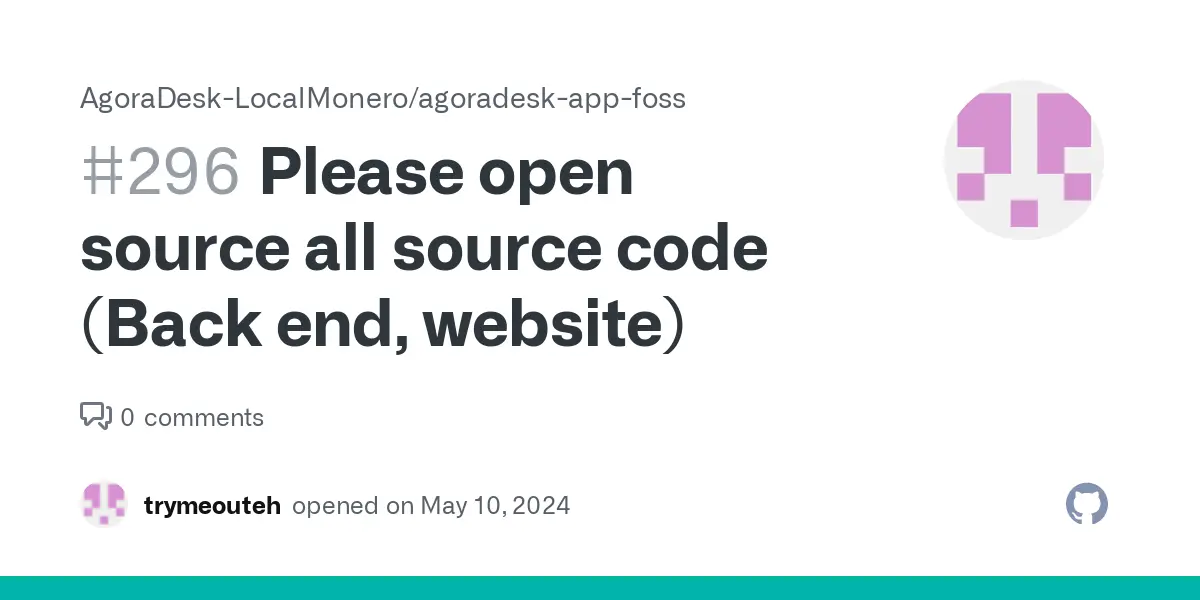If the AgoraDesk source code is released? Maybe? It can help anyone who wants to create a P2P trading platform. I think Haveno is written in Java and I have a hunch that AgoraDesk back end is not in Java.
- 7 Posts
- 11 Comments
https://github.com/AgoraDesk-LocalMonero/agoradesk-app-foss/issues/296
I hope AgoraDesk/LocalMonero will release all of their source code for their platform after they shutdown to allow anyone to fork it and start their own platform without having to build a platform and app from scratch
https://github.com/AgoraDesk-LocalMonero/agoradesk-app-foss/issues/296
Please upvote this issue if you want to see all the source code for AgoraDesk/LocalMonero be released!

 1·4 months ago
1·4 months agoNot a bad idea as long all nodes will allow any wallet to recover all funds, not all transaction history, just balance.

 2·4 months ago
2·4 months agoI think all cryptocurrency blockchains that function as money or store of value should do this. However I think 1 years worth is better than 10 years worth of data, or perhaps even less than a years worth of data.
As long as the blockchain size remains small enough for the adverage Joe to store the entire chain onto their mining computer for when or if Monero reaches mainstream mass adoption usage. By mainstream mass adoption I mean Monero is used as much as Visa or Mastcard is globally which I would assume will mean that Monero will need to handle 1 million transactions per second.

 2·9 months ago
2·9 months ago

 1·10 months ago
1·10 months agorun unsnap?
 1·11 months ago
1·11 months agoCan they purge all posts, comments and communities from another instance with one click of a button?
 1·1 year ago
1·1 year agoWill rust be able to scale horizontally in the future?
 4·1 year ago
4·1 year agoTo my understanding vertical scaling has limits which is the servers limitations as horizontal scaling if infinite since unlimited servers can be added

I think stablecoins will always have a centralized point of failure. Weather it is an algorithm, or having the coin backed by the actual asset.
I think the best stablecoins are backed by the asset 1 to 1 or a little more then 1 to 1. Most stablecoins that do this are token on smart chain contracts which have another vulnerability which is being a smart contract. Smart contracts could contain a vulnerability and if it does have a vulnerability, a new contract will need to be made and users will have to switch their old token to the new tokens. Also censorship is an issue. https://cryptonews.com/news/tether-takes-action-blacklists-validator-address-linked-25-million-mev-bot-drain-heres-what-happened.htm
And these stablecoins are not private. The only private stablecoin platform out there is Haven but Haven assets are not backed 1 to 1.
I hope there are plently of stablecoins issued on Zano in the future. Zano allows you to create an asset without creating a smart contract. All assets on Zano are private. I would like to see Tether, USDC and other issue stablecoins on Zano. Trusting the issuers on backing the stablecoin and trusting the issuer to secure their private keys to prevent hackers from inflating the asset will be the only vulnerabilities, but you will have privacy and a censorship resistant stablecoin!